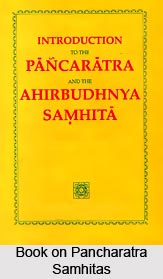 Pancharatra Samhitas fall within the purview of Tantra literature. Samhitas are the sacred books of the Vaishnava sect of Hinduism. The Pancharatra Samhitas are also part of the Vishnuite Samhitas. Though the traditional list enumerates 108 Pancharatra Samhitas, there is actually mention of more than 215. However of this only twelve have been published. Though the Pancharatra Samhitas probably originated in the North, the earliest of them perhaps dating from the 5th-9th century A.D. it is mainly in the South that they circulated.
Pancharatra Samhitas fall within the purview of Tantra literature. Samhitas are the sacred books of the Vaishnava sect of Hinduism. The Pancharatra Samhitas are also part of the Vishnuite Samhitas. Though the traditional list enumerates 108 Pancharatra Samhitas, there is actually mention of more than 215. However of this only twelve have been published. Though the Pancharatra Samhitas probably originated in the North, the earliest of them perhaps dating from the 5th-9th century A.D. it is mainly in the South that they circulated.
One of the earlier Samhitas is the Ahirbudhnya Samhita, a Kashmiri work which probably originated not long after the fourth century A. D. The work takes the form of a conversation between Ahirbudhnya, i.e., Lord Shiva, and Narada. The smaller portion of the work is philosophical in content, and the greater portion occult. Several chapters deal with the Creation. In connection with the Creation Chapters 12 and 13 give a very interesting survey of the "sciences," i.e., the various systems of religion and philosophy. Then comes the rules for the castes and Asramas. The paterfamilias and the forest hermit attain to the heaven of Brahman, but the ascetic (Sannyasin) is said to be `extinguished like a lamp`. Chapter 16-19 deal with the mysterious significance of the letters of the alphabet. Other chapters give a fine description of the ideal teacher. He is not only to know the truth of the Vedas and be ever mindful of the ceremonies due to the gods and the fathers, but he should also be a "non-speaker of evil speech, a non-doer of evil deeds and free from envy of the good fortune of others..". Chapters 21-27 describe diagrams which can also be used by amulets. Further chapters deal with the cult, the theory and practice of Yoga, the hundred and two magic weapons, i.e., secret powers by which might can be attained. A few chapters deal with ceremonies to be performed by a king when in danger during time of war, in order to ensure victory. Sorcery forms the subject-matter of several chapters. An appendix (Parisista) contains a hymn of the thousand names of the divine Sudarsana.
One of the earlier of the Southern Samhitas is the Isvara Samhita, quoted by Ramanuja`s teacher Yamuna, who died in about 1040 A.D. Ramanuja himself quotes the Pauskara Parama and Sattvata Samhitas. On the other hand, the Brhadbrahma Samhita, which is supposed to belong to the Narada Pancharatra already contains prophecies regarding Ramanuja, and cannot, therefore be earlier than the 12th century. The Jnanamrtasara Samhita, which is published with the title `Narada Pancharatra,` and is entirely devoted to the glorification of Lord Krishna and Radha, is quite a modern and fictional work. As the cult taught in this book agrees most with that of the Vallabhacharya sect, it appears to have been written a little before Vallabha at the beginning of the 16th century.
These are therefore the Pancharatra Samhitas, an essential component of Tantra literature.













